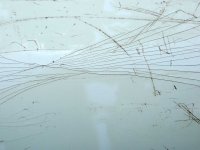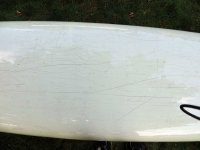After about 25 years of abuse from hidden rocks or a mad dash to a rocky shore thanks to some thunder/lightening, my very well travelled Shearwater is in need of some serious TLC.
Keep gouges/scratches and 4 or 5 spider webs are starting to look dangerous. Any ideas on repair would be greatly appreciated.
Ted, like a lot of boat repairs there is a “right” way, a “less right way” and a “no way” to do gel coat repairs. The large impact spider crack in the first photo would worry me.
Before anything else I would inspect the inside of the hull at that spider crack and see if any damage is visible; that could be broken fibers or sorta spider-cracky lines where the resin and cloth have parted ways. That would worry me more than the gel coat damage, and I’d lay a “can’t hurt” peel ply’ed patch across it on the inside before doing anything else. That will at least stiffen the damaged area, and maybe keep the gel coat cracks from flexing wider apart or further lifting off.
The “right” way to tackle the spider cracks would be to remove anything flakey or lifting and lay new gel coat in the voids. At least it is a white hull, so the color match won’t be too many shades off.
There is probably a (time consuming, labor intensive, why bother) “right” way to fill the still-tight spider crack areas, but not for me. But “4 or five dangerous looking spider cracks” would be enough for me to eventually do something.
As a “less right” way, if the gel is still firmly attached and not lifting or seemingly ready to flake, would be to sand the spider cracked area and the deep scratches & gouges, and paint/fill them with resin (maybe some G/flex in the mix).
Let it cure, lightly sand/wash and paint at least the patches, if not the entire hull, with a couple coats of white paint. Anything from hardware store oil based enamel to a one or $$$ two part epoxy paint; the latter choices get pricier, and only worthwhile if you are painting the entire hull.
A quart of whatever will paint a 16’ canoe at least 3 coats worth, and once you have rolled on and tipped out the first coat it is worth some gentle wet sanding/washing prep and gunwale re-taping to lay down a second or third coat.
If you don’t care how battle scarred it looks, skip the paint. For now.
The “no-way” fix is simply that. If the gel coat seems well adhered, and there is no visible/structural damage on the inside, just leave it be ‘til it gets bad enough.
Or ‘til you can’t stand it no more. The difference may be psychological, but a clean, smooth bottom
seems to maintain cruising speed and glide with less effort. I doubt the effect is sufficiently measurably while paddling, but even if it’s all in my mind, I’ll take it.
With gel coat or epoxy and possibly a few coats of paint I’d avoid it as a winter project, unless you have a heated shop in Ottawa. If you do wait ‘til winter, when the canoe is more couple-weeks-in-the-shop available, an electric radiant oil heater, set midships under a heat-capturing gunwales-down canoe, will keep the hull gently warm even when the shop temps dip towards freezing.
The nice part about those repairs is that they are, by necessity, a couple hours an evening with a lot of wait to cure time. While you are twiddling your thumbs waiting for epoxy to cure you could sand and re-varnish any brightwork.
Or lay down Dynel skid plates while you have the epoxy and etc out. A little white pigment in the epoxy mix, peel ply compressed Dynel, white paint coat on white skid plates on white hull. . . . .just sayin’
And of course the prep work, done thoroughly and carefully, will take 90% of the work time, which is a fine way to putz around an hour or two a night.




